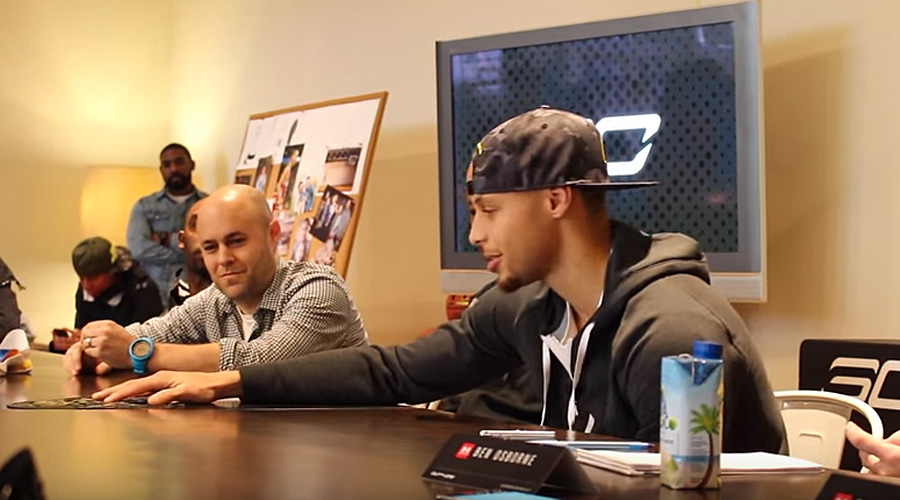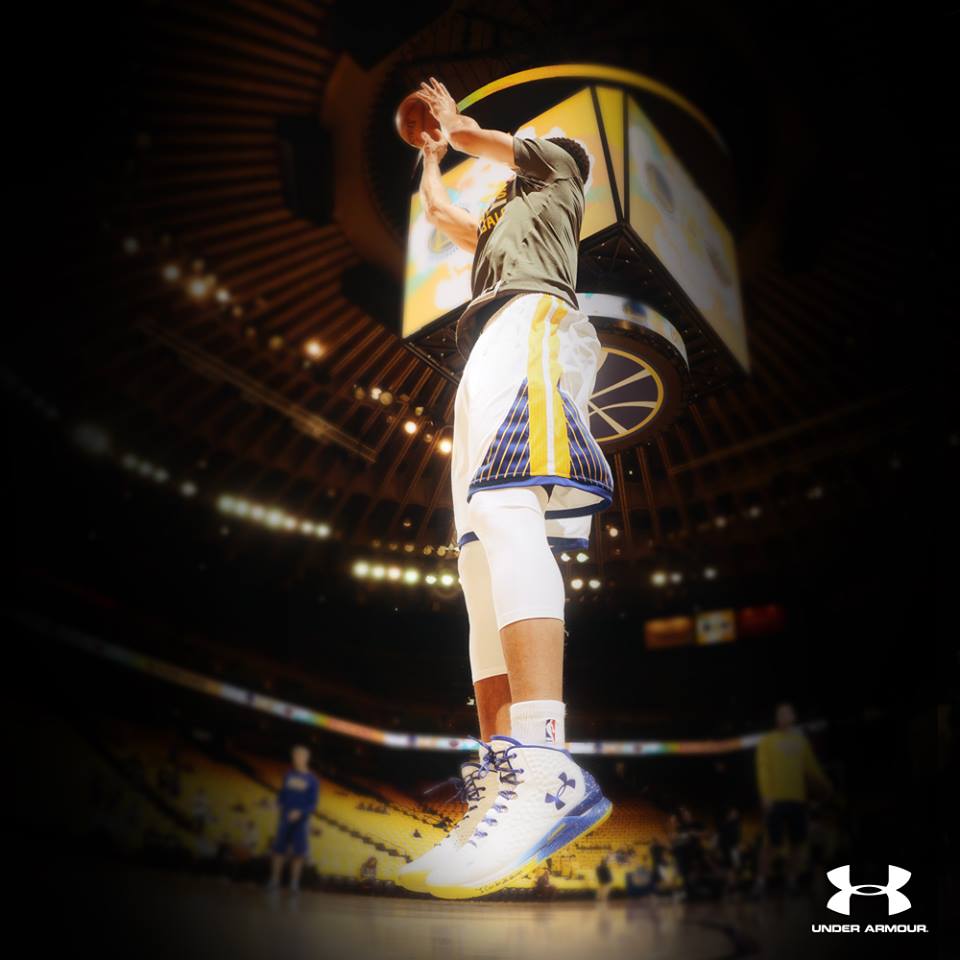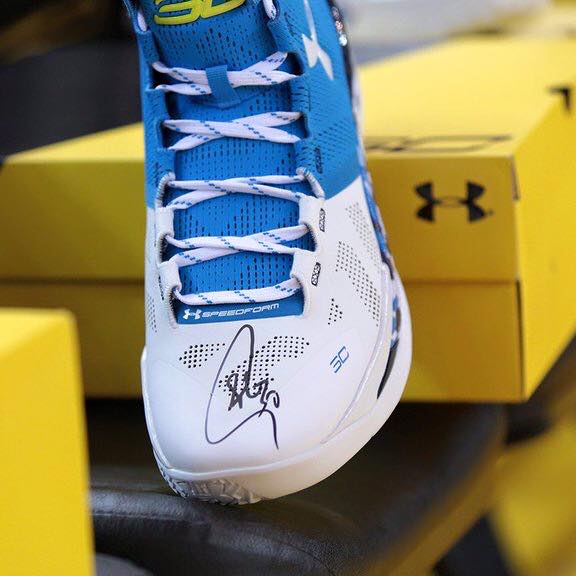Ratchet up the the rivalry between Under Armour and Nike one more notch.
Three months after leaving to take a job with Nike, Dave Dombrow, the mastermind behind the Curry 1, is coming home to Under Armour and getting a promotion.
The re-hiring of Dombrow (pictured above with Stephen Curry) comes as footwear has become Under Armour’s strongest revenue growth driver with the brand gaining traction in the running category and scoring a blockbuster hit with Stephen Curry’s signature line of basketball shoes. Many investors see the category driving its next leg of growth.
It also comes in the heat of a growing talent battle among Under Armour, Nike and Adidas as the top three sporting goods giants have traded blows, luring each others’ employees to jump ship, and in this case, jump back.
Dombrow will rejoin UA as chief design officer, beginning August 1. In the newly created role, he will guide the design of Under Armour’s entire collection of footwear, apparel and accessories. Previously, he was SVP of creative footwear and accessories.
In a statement, Under Armour said Dombrow had been “integral” to driving growth in the footwear category since joining the company in 2010. He was credited as the co-creator of the UA SpeedForm Apollo, which was named “Best Debut” by Runner’s World magazine in its 2014 Spring Shoe Guide and showed that Under Armour was committed to bringing innovation to the footwear category. Touted as the first athletic shoe to be built in a bra factory, the SpeedForm Apollo utilizes a full-length 4D foam sock liner to conform to the foot’s exact shape.
In basketball, Dombrow was credited in the statement as the “visionary” behind the Curry 1, Stephen Curry’s first signature shoe. The Curry line-up now includes the Curry 2 and the soon-to-arrive Curry 2.5. The star guard’s wildly successful season this year was particularly pumped sales of his signature shoes.
“In his time at Under Armour, Dave played an instrumental role in creating innovative and cutting-edge footwear with international acclaim,” said Under Armour founding partner, Kip Fulks. “As Under Armour continues to evolve the key pillars of innovation and design while expanding global growth in all categories, Dave’s unique abilities to challenge the status quo and to anticipate the needs of the future athlete are exactly what we need to further our success.”
In March, reports surfaced that Dombrow was leaving Under Armour to take an undisclosed post at Nike. Due to a non-compete clause, he wasn’t expected to begin working at Nike until 2017.
The move was seen as a blow to Under Armour as the brand’s footwear sales have been gaining momentum, driven by success in basketball, a category Nike dominates. Launching with football cleats, the company has been in the category for ten years and has only recently gained traction in bigger running and basketball categories.
In the first quarter, Under Armour’s footwear revenues jumped 64 percent to $264.2 million, by far the brand’s strongest growth category. Its core apparel category was up 20 percent.
The gains were driven by the Curry 2, a model that has consistently ranked as a top seller among signature shoes week after week this year and has been the bright spot in a softer category this year.
“Stephen’s phenomenal season has brought unprecedented attention to our overall footwear business, and especially basketball footwear, and is driving both door expansion with our key mall partners and credibility with the hard-core basketball kid,” said Kevin Plank, Under Armour’s CEO, on the company’s first-quarter conference call with analysts.
The Curry 2.5, the shoe the star guard is wearing during the playoffs, will go on sale on July 1.
“We recognize that Stephen’s ascent to the top of the basketball world creates a once-in-a-generation opportunity for our brand, and our team is laser focused on delivering against that potential,” added Plank.
Outside basketball, Under Armour is finding success with more premium footwear introductions, including the $150 Gemini 2 RE running shoe, the first UA Record Equipped running shoe that interfaces with its Connected Fitness platform. Another success was the UA Architect, Under Armour’s first shoe with a 3-D printed midsole, which sold out in 19 minutes on its e-commerce site at a retail price of $300.
In April, UA launched a new line of golf footwear with the help of Jordan Spieth at prices ranging from $160 to $220. The success in higher-priced shoes helped footwear ASPs grow in the high single digits in the quarter.
Under Armour is expecting annual footwear sales to more than double to $1.7 billion in annual footwear sales by 2018, up from $677.7 million in 2015. The company is also building a new 100,000 square-foot headquarters in Portland, OR to attract footwear talent.
The move marks the second time Dombrow has left Nike. He previously worked as a designer from 2000 to 2003. He then moved onto the defunct-GBMI, which had ran shoe brands under licensed arrangements such as Diesel, Pony, Nautica and Sean John; and then to Puma before enduring another non-compete period to join Under Armour.
While the major players typically battle over star player and university endorsements, poaching talent appears to becoming the new competitive game. In late 2014, three Nike designers – Marc Dolce, Denis Dekovic and Mark Miner – agreed to join Adidas and set up a Brooklyn design studio. The hiring led to a lawsuit and the three only joined Adidas in March.
With Nike’s dominance of the category, recruiting Dombrow was seen largely as way to slow Under Armour’s momentum in footwear, particularly in basketball. In its latest fiscal year, Nike’s global footwear sales were $18.3 billion – nearly 30 times Under Armour’s levels – including $8.5 billion in sales in North America.
For Under Armour, the rehiring underscores the company’s commitment to the footwear category, although it also comes after the company revealed in early May that Henry Stafford, its chief merchandising officer, as well as its chief digital officer, Robin Thurston, had left the company.
For Dombrow, who will be working out Under Armour’s headquarters in Baltimore, rejoining Under Armour gives him a chance again to once again play David against footwear’s Goliath.
“I continue to be humbled and amazed by what we have built together, fueled by the core commitment to innovation and design, as well as the entrepreneurial drive to make all athletes better,” Dombrow said. “I can’t wait to help create our next chapter.”
Photos courtesy Under Armour


















